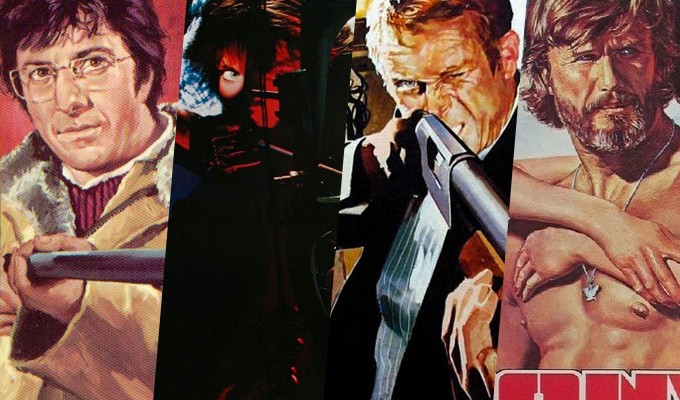Starting today and running until April 7th, the Film Society of Lincoln Center is running a complete retrospective of the films of the notorious Sam Peckinpah. Not to be outdone, so are we — Peckinpah’s relatively short but stormy filmography is one of the most rewarding to revisit, especially as, more than most directors of his turbulent, cinematically fertile era, it can be viewed as a kind of ongoing project in reassessment and rehabilitation, not to mention a fascinating prism through which to examine changing attitudes to sexism, classism, racism and the masculine ideal.
Oftentimes, though, that scholarly reassessment has been a search for reasons and, well, excuses for liking his films — justifications for why these often brutish movies, full of testosterone-pumped machismo and orgiastic portrayals of violence are in fact pacifist in their outlook, or contorted arguments for how we can interpret Peckinpah’s many scenes of sexual violence and rape as somehow feminist. But not only does that thinking lead to a certain denial-based madness (if there is a signature shot of a Peckinpah woman-cipher, it’s probably her having her shirt ripped open to expose her breasts, often followed by a slap in the face), it also glosses over the real fascination of this unique and highly problematic corpus of work: Peckinpah’s artistry is not something that can or should be separated from its thematic politics because that’s precisely where so much of his artistry lies. It’s uncomfortable to consider the possibility that some of his films might not only be compelling and politically obnoxious, but compelling because they are politically obnoxious, but that discomfort is part of the heat and energy his films give out.
Nobody is ever just one thing, and Peckinpah as a filmmaker is many contradictory and conflicting things at once. His misogyny, while undeniable, is not simple — it is alloyed with a hyper-critical view of masculinity too, just as a similar current of attraction/repulsion, glorification/condemnation flows through his depiction of violence. And perhaps the biggest contradiction of all was the man himself — in contrast to the John Huston/Ernest Hemingway model of the egomaniacal genius hellion that somehow clings to him, Peckinpah, in the words of Pauline Kael had a “quiet that attracted attention; he was the model of the hard-luck passive/aggressive.” His drinking (he famously announced at one point that he could no longer direct while sober) seemed less about rabble-rousing and hellraising than a kind of desperate attempt to keep his head above water. And later in life when his alcoholism, failed marriages, fractious professional relationships and drug addiction had taken hold, he seemed, to quote one shocked interviewer, “fragile… he did not strike me as someone capable of the legendary mayhem and madness generally attributed to him.”
With just fourteen theatrical feature films to his name, eight of which, including most of his touchpoints, came during the seven years 1969-1975, Peckinpah burned brightly and briefly and brutally, and he left behind one of the most continually contentious and provocative bodies of work within that generation of ’70s filmmakers, who redefined the frontiers of American filmmaking as though it were their own personal Wild West.

“The Deadly Companions” (1961)
Recommended as a TV writer by friend and mentor Don Siegel, Peckinpah wrote for several serial westerns in the mid-’50s and a couple of his scripts even inspired serials of their own — “The Rifleman,” and then in 1960 “The Westerner” starring Brian Keith, on which he also directed. Cancelled after just 13 episodes run it was well regarded enough that when Keith suggested Peckinpah make his big screen directorial debut on this 1961 film, the producer acquiesced. That producer was the brother of the film’s main star,Maureen O’Hara, which means that ironically, notorious misogynist Peckinpah’s first film was really a vehicle for one of the few major actresses, aside from Barbara Stanwyck and Joan Crawford, who projected an image of strength as a Western heroine. Sadly, however that’s sort of where the interestingness of “The Deadly Companions” ends: whether due to Peckinpah’s unsuitability, inexperience or his hamstringing at the hand of that same producer, the film is pretty forgettable. The story of a “fallen” woman and the man who accidentally killed her child, the unconvincing chemistry and unsteady characterization of the leads makes it feel like a quickie B-movie, if a competently made one. And while O’Hara’s fiery redhead routine always yields some pleasures here it’s in service of a story not so much about love conquering all and her forgiving her son’s killer, but about proving her dead child’s legitimacy — an agenda that must have seemed regressive even in the early 1960s. And as is standard even for the more sympathetic females in Peckinpah’s Western canon, when she’s not being a frivolous distraction from the bland hero’s main, manly mission, she’s a borderline incapable liability in terms of such practicalities as driving a wagon or digging a hole. Many Peckinpah films are unjustly overlooked; this one, not so much. [C]

